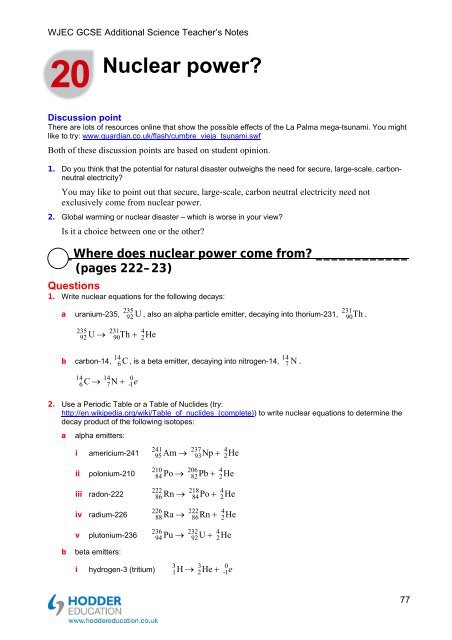Teacher's notes and answers to questions in the book - Hodder Plus ...
Teacher's notes and answers to questions in the book - Hodder Plus ...
Teacher's notes and answers to questions in the book - Hodder Plus ...
You also want an ePaper? Increase the reach of your titles
YUMPU automatically turns print PDFs into web optimized ePapers that Google loves.
WJEC GCSE Additional Science Teacher’s Notes<br />
20<br />
Nuclear power<br />
Discussion po<strong>in</strong>t<br />
There are lots of resources onl<strong>in</strong>e that show <strong>the</strong> possible effects of <strong>the</strong> La Palma mega-tsunami. You might<br />
like <strong>to</strong> try: www.guardian.co.uk/flash/cumbre_vieja_tsunami.swf<br />
Both of <strong>the</strong>se discussion po<strong>in</strong>ts are based on student op<strong>in</strong>ion.<br />
1. Do you th<strong>in</strong>k that <strong>the</strong> potential for natural disaster outweighs <strong>the</strong> need for secure, large-scale, carbonneutral<br />
electricity<br />
You may like <strong>to</strong> po<strong>in</strong>t out that secure, large-scale, carbon neutral electricity need not<br />
exclusively come from nuclear power.<br />
2. Global warm<strong>in</strong>g or nuclear disaster – which is worse <strong>in</strong> your view<br />
Is it a choice between one or <strong>the</strong> o<strong>the</strong>r<br />
_Where does nuclear power come from ____________<br />
(pages 222–23)<br />
Questions<br />
1. Write nuclear equations for <strong>the</strong> follow<strong>in</strong>g decays:<br />
a uranium-235,<br />
235<br />
231<br />
92 U , also an alpha particle emitter, decay<strong>in</strong>g <strong>in</strong><strong>to</strong> thorium-231, 90 Th .<br />
235<br />
231<br />
92 U 90 Th <br />
4<br />
2<br />
He<br />
b carbon-14,<br />
14<br />
6<br />
C <br />
14<br />
7<br />
14 14<br />
6 C , is a beta emitter, decay<strong>in</strong>g <strong>in</strong><strong>to</strong> nitrogen-14, 7 N .<br />
N <br />
0<br />
-1e<br />
2. Use a Periodic Table or a Table of Nuclides (try:<br />
http://en.wikipedia.org/wiki/Table_of_nuclides_(complete)) <strong>to</strong> write nuclear equations <strong>to</strong> determ<strong>in</strong>e <strong>the</strong><br />
decay product of <strong>the</strong> follow<strong>in</strong>g iso<strong>to</strong>pes:<br />
a alpha emitters:<br />
241 237 4<br />
i americium-241 95 Am 93 Np 2He<br />
ii polonium-210<br />
iii radon-222<br />
iv radium-226<br />
210<br />
206<br />
84 Po 82Pb<br />
<br />
222<br />
218<br />
86 Rn 84Po<br />
<br />
226<br />
222<br />
88 Ra 86Rn<br />
<br />
4<br />
2<br />
4<br />
2<br />
4<br />
2<br />
He<br />
He<br />
He<br />
236 232 4<br />
v plu<strong>to</strong>nium-236 94 Pu 92U<br />
2He<br />
b beta emitters:<br />
3 3<br />
i hydrogen-3 (tritium) - 0 1 H 2He<br />
1e<br />
77

















